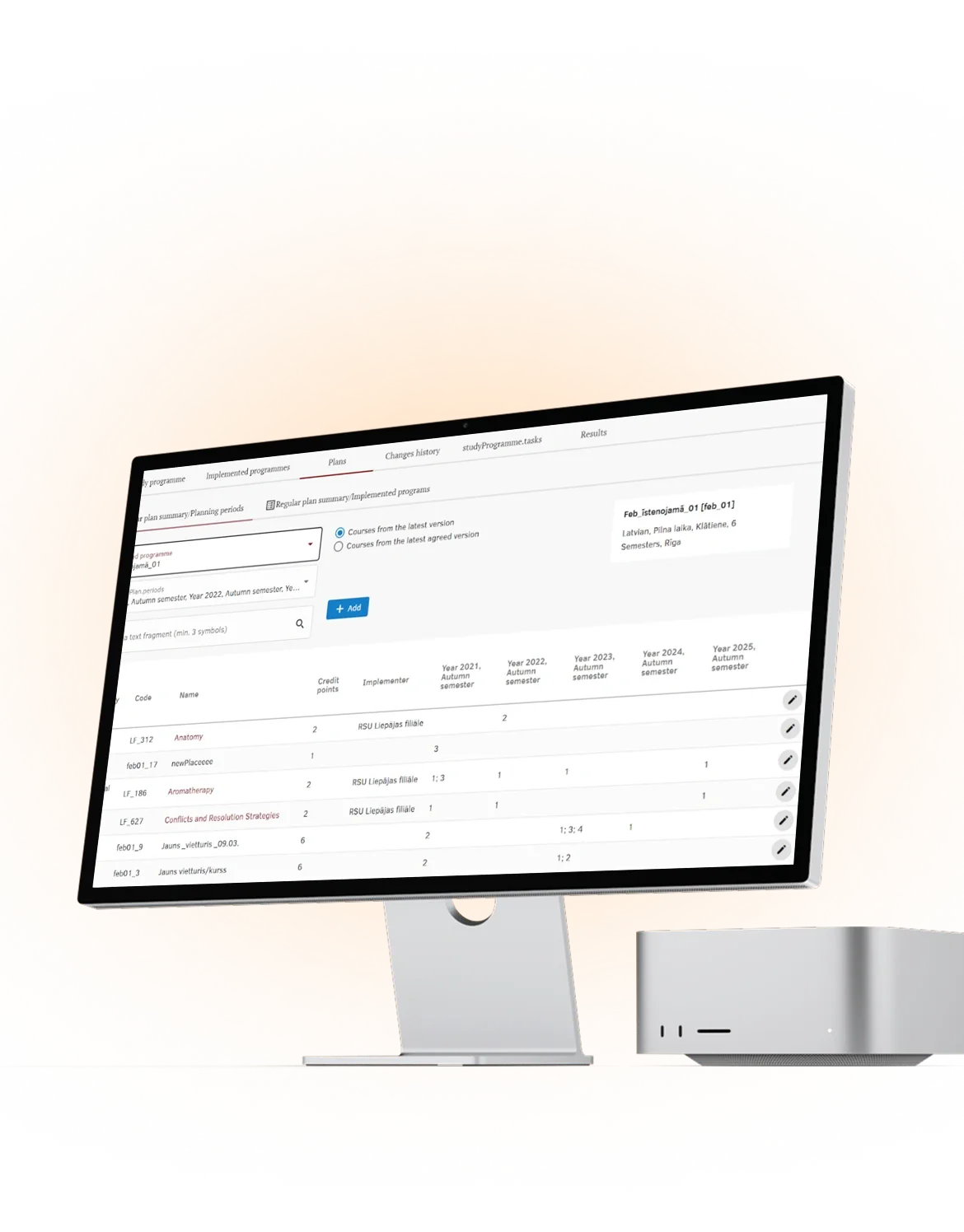
INTRANET PORTAL FOR EDUCATION COMPANY
58%
reduced workload
67%
performance boost
38%
more positive user feedback
Challenge
Enhancing efficiency in complex educational processes, including data integration, dynamic content management, and curriculum, for a leading IT education provider.
Solution
Robust user-friendly intranet platform capable of processing and recording multiple inner accreditation processes during the dynamic part of study terms.
Tech stack
Angular 12, Material-Ul, SQL, .NET Core, ASP.NET, Azure.
Client
Our client is a prominent European company specializing in software development, e-learning courses, and IT training. Their team offers a wide range of services in the field of IT education, focusing on the integration of cutting-edge systemic information solutions into businesses. As their operations expanded, the need for enhanced platform capabilities to efficiently process and manage multiple data streams became evident.

Challenge
Recognizing the profound challenges associated with business growth in the education sector and the paramount importance of addressing them, our dedicated team embarked on the journey to develop a robust learning environment. We understood that seamless adaptation to the dynamic nature of educational offerings was paramount. This involved integrating custom solutions to address challenges such as:
- Sufficient integration of relevant changes: Adapting to the dynamic nature of educational offerings necessitated the seamless integration of relevant changes into existing modules of the platform.
- Complex data visualization: Displaying a multitude of interrelated data elements, including syllabus forms, a variety of courses, and specialities.
- Limited curriculum editing solution functionality: The existing platform had limitations in terms of existing curricula management and adding new ones.
- Time-consuming e-learning processes: Organizing efficient educational processes from course creation to enrollment management saving a substantial amount of time.
- Resource-intensive syllabus management: Adjusting the processes of arranging and recording syllabi promptly.

Got a similar software development project on your mind?
Estimate a precise timeframe for its implementation.
Team
1
Project Manager
1
Tech Lead
4
Software developers
2
QA engineer
1
Business Analyst
1
UI/UX Designer

Process
Initiation
At the outset of the project, the Modsen team initiated client interactions, streamlined resource allocation, and maintained vigilant technical oversight.
Client collaboration and data gathering: We conducted online meetings with the client to understand their core business goals, and our business analyst collected data-driven requirements to shape the project.
Technical oversight: The CTO ensured technical excellence from the beginning, guiding educational technology stack choices and architectural decisions.
Discovering
In pursuit of superior results, we meticulously compiled and organized all the data acquired from our online meetings and discussions with the client. The client actively participated in the final decisions regarding the technologies to be used in the upcoming development phase. We collaborated closely, enabling the client to review and adjust the UI and UX design according to their preferences for their platform.
Leveraging our extensive experience from previous projects, we created a comprehensive list of key factors to consider. This served as the foundation for discussions on implementing the Agile approach, ensuring the swift and efficient development of the educational portal.
Development
Modsen developers have long adhered to the Scrum methodology , ensuring stable and incremental solution development. By breaking down each stage into smaller processes, the development team effectively addressed emerging issues on time, delivering tangible value with each iteration.
Infrastructure
In the context of intranet solutions, creating a robust and scalable infrastructure was a critical component to facilitate data sharing, real-time insights, and efficient communication within the same network. Our team leveraged Microsoft Azure, a cloud platform known for its scalability and reliability, to establish a robust and scalable infrastructure serving as the backbone of seamless operations. Key technical considerations included:
Server architecture: We carefully designed the server architecture, focusing on load balancing, redundancy, and failover mechanisms to ensure high availability and performance, vital for educational intranet portals.
Database systems: To achieve efficient data processing, we implemented an optimized database management system (DBMS) using SQL. The DBMS was fine-tuned for storing and managing educational content, user data, and other critical information, ensuring high-performance data operations.
Data security: Security measures, such as encryption protocols, firewall configurations, and remote access controls, were rigorously implemented to safeguard sensitive educational data within the intranet portal for education.
Real-time communication: Leveraging WebSocket technology, we established real-time communication channels to support live interactions and notifications among users.
Scalability and elasticity: The infrastructure was designed with scalability in mind, employing cloud-based solutions that allowed us to dynamically adjust resources to accommodate varying workloads.
Architecture
With the goal of crafting a robust architecture that seamlessly integrated existing microservices for the educational portal, the development team harnessed the full potential of .NET Core, a technology stack ideal for building a resilient platform for educational purposes. The key technical aspects included:
Microservices synergy: The architecture was meticulously designed to ensure synergy between existing microservices, enhancing the overall functionality and interconnectivity of the intranet portal for IT education.
Backend database: An established backend database, powered by SQL or similar technologies, played a pivotal role in facilitating a dynamic flow of information. This strengthened existing processes conducted within microservices, enabling efficient data exchange and management.
Real-time regulation with ASP.NET: The implementation of ASP.NET development tools allowed for real-time regulation and curriculum management, ensuring that the software could facilitate live interactions, communication, and monitoring in an educational context, making it an ideal solution for the dynamic needs of the education sector.
The architectural approach, tailored to the specific needs of an intranet educational portal, formed the foundation for a platform that could efficiently serve the educational community by seamlessly integrating microservices, enabling real-time interactions, and facilitating the dynamic flow of educational information.
Coding and quality assurance
In the heart of development, where code meets quality assurance, the Modsen team harnessed the power of Material-UI and SQL to meticulously craft both the front-end and back-end functionalities of the educational platform.
Microservices synergy: The architecture was meticulously designed to ensure synergy between existing microservices, enhancing the overall functionality and interconnectivity of the intranet portal for IT education.
Front-end development with Material-UI: Leveraging Material-UI was instrumental in crafting a user-friendly and accessible UI for the Intranet educational platform. This extensive toolkit provided the resources to establish an intuitive and visually appealing interface, seamlessly aligning with predetermined timelines, a critical aspect for a solution designed by e-learning app developers for this purpose.
Back-end features with SQL: SQL, chosen for back-end development of the educational portal, addressed existing challenges, including the lack of editing capabilities and insufficient storage capacity for a growing educational platform. SQL, known for its prowess in working with databases, offered a broad variety of interactions for users and allowed for the implementation of advanced storage solutions to manage the rapidly increasing amount of educational information.
Testing and quality assurance: Throughout the implementation process, our team conducted a series of rigorous testing processes to ensure the integrity and accuracy of each feature. This included comprehensive unit tests to evaluate individual components, integration tests to examine the interactions between different parts of the system, and user acceptance tests to confirm that the virtual learning environment developed met the educational domain’s specific needs. Such an approach guaranteed that the intranet application was not only robust but also highly reliable in delivering its intended functionalities to educators and learners.
This phase underscores the technical expertise that went into the development of the intranet learning portal, ensuring that both the front-end and back-end were optimized to meet the precise requirements of the education sector.

Regular demos for client
Modsen regards visualizing interim development results as essential for ensuring client satisfaction and gathering valuable feedback. Each product iteration provided stakeholders with a clear view of potential paths for evolution, enabling them to make adjustments, share insights, and align with the company’s needs.
Third-party audit
Conducting a third-party audit helped both the Modsen developers team and the client to be fully aware of the Intranet educational technology’s security aspect. Through the application’s code and infrastructure accessibility practices followed by handling capacities review, we were able to identify positions for strengthening and reassuring the client’s confidence.
The integration of a third-party audit, along with essential certifications, played a pivotal role in ensuring the security, data protection, accessibility, and compliance of the educational portal.
Code-level security: The audit meticulously examined the codebase, aligning with certifications like ISO 27001, ensuring that the code met the highest data protection and security standards.
Infrastructure resilience: The infrastructure was evaluated to align with data protection regulations (GDPR) and accessibility standards (WCAG).
Security certifications: We considered ISO 27001 to reinforce Intranet information security management, enhancing the overall security of the intranet portal for education.
This combined approach ensured not only robust technical features but also compliance and security, catering to the specific needs of our educational client.
Acceptance testing
To verify that the solution met the specific requirements, the client conducted acceptance testing. Thorough tests were performed on each functionality, ensuring that the agreed-upon criteria were met. Any feedback received during testing was promptly addressed to refine the custom Intranet education solution before its final release.
Closing
Upon project closure, the client received a fully operational solution, primed and ready for production, with a host of essential materials to support its deployment and management within the education sector:
Production-ready intranet portal: A fully equipped intranet portal, incorporating all discussed and tested features, was prepared for launch, ensuring effective service for educators and learners.
Comprehensive codebase: The entire software’s codebase, including front-end, back-end, and associated scripts, was provided, granting the client full control for customizing the education software and its maintenance as needed.
Technical and business analyst documentation: Extensive technical documentation outlined the architecture, technology stack, and technical specifications of the Intranet Portal. Business analyst documentation included data-driven insights and project-shaping recommendations.
User-friendly guide: To facilitate seamless onboarding and user adoption, a user guide was supplied, aiding educators, administrators, and learners in effectively utilizing the Intranet Portal's features. This guide ensured a smooth transition to the new educational platform.
With these deliverables, the client fully possessed the essential tools to launch the intranet portal successfully, enabling them to continually enhance and expand their educational services. The solution offered greater capacities for streamlining internal processes and addressing the unique challenges of the education sector.


Solution
In crafting the solution for the intranet study portal, Modsen prioritized prompt decision-making, agile adaptation to evolving development conditions, and effective communication with the client’s team. This approach allowed our developers to efficiently complete assigned tasks on the fly, delivering an innovative e-learning platform tailored to the educational sector.
Key technical aspects of our solution included:
- Intuitive user interface: a convenient visual representation of broad functionality.
- Extensive list of interactions: comprehensive editing potential of internal aspects.
- Empowered microservices logics: error-free conducting of multiple processes.
- Magnified storage capacity: utilizing SQL to expand existing storage range.
- Seamless integration: ensuring successful integrity with internal components.
Result
The results of our collaborative efforts with the Modsen team speak volumes of our commitment to achieving and surpassing the stated objectives, ultimately elevating our client’s services to an entirely new level. The success of this project not only meets current demands but also opens doors to remarkable possibilities for further improvements.
58%
Reduced workload for teaching staff67%
Performance increase38%
Boost in user ratingsLet's calculate the accurate cost and resources required for your project